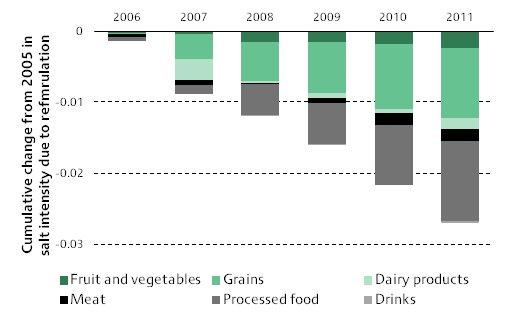In 2003 the UK Government set a target of reducing the average salt intake of adults to 6g per day. To help achieve this it adopted a two pronged salt reduction strategy, encouraging voluntary product reformulation by the food industry and simultaneously running a consumer awareness campaign that highlighted the negative health risks associated with high salt intake.
Recent analysis by IFS researchers, published as an IFS Working Paper, finds that between 2005 and 2011 there was a 5.1% reduction in the average salt content (grams per 100g) of British households’ grocery purchases. It also shows that the actions of firms were crucial in driving the decline in the salt content of grocery purchases. The decline was entirely due to the reformulation of food products by manufacturers to reduce their salt content; households actually switched slightly towards saltier food products.
These findings point towards the potential effectiveness of encouraging product reformulation in reducing the intake of other nutrients that might be consumed in excess, such as sugar and saturated fat. This strategy has the potential to change the diets of individuals who might be resistant to changing their behaviour. Despite the recent marked decline in salt intake, in 2010, according to the Health Survey for England, 60% of people were still consuming more salt than the government’s targeted population salt intake of 6g per adult per day, and the average salt intake was 7.9g per person per day. Therefore the government still has a long way to go to reach its goal.
The research uses data from the Kantar Worldpanel on the food grocery purchases made for consumption inside the home by a representative sample of British households from 2005 to 2011. The sample includes 15,000 to 25,000 households at any point in time. We decompose the 5.1% reduction in the average salt content of households’ grocery baskets into the proportion that was due to:
1. Households switching between food products, for example, switching from salted to unsalted butter, or from crisps to apples
2. Product reformulation by firms to reduce the salt content of food products
We find that the decline in average salt content of grocery purchases was entirely due to product reformulation by firms. The effect of consumer switching was to slightly increase the average salt content of the shopping basket between 2005 and 2011. If consumers had not switched to saltier products, then the average salt content of grocery purchases would have fallen by 6.5% (compared to the 5.1% that actually occurred).
We split the overall effect of product reformulation on the salt content of grocery purchases into the contribution made by six broad food groups. Figure 1 shows that reformulation of products in the processed food and grains groups were principally responsible for the decline in the average salt content of households’ shopping baskets. This was primarily due to reformulation of bread, condiments, breakfast cereals, biscuits, pastry and pies.
Figure 1. Effect of product reformulation, by food group

Source: Calculated from Kantar Worldpanel 2005-2011 data.
The impact of reformulation was larger for households in lower socioeconomic groups, in part because these households, on average, buy a larger share of their groceries as processed food. However, households in the lowest two socioeconomic groups (groups D&E) switched more strongly, on average, towards saltier food products compared with households from higher socioeconomic groups, partly offsetting the greater benefit they received from product reformulation.
These results highlight one of the advantages of targeting product reformulation compared with a public information campaign; reformulation has the potential to affect all consumers, while the provision of information is likely to affect different groups of households to varying degrees (if at all). In particular, reformulation is an effective way of changing the diets of individuals who may be unable or unwilling to process the information provided to them. It may also be that these are the individuals that policymakers are most interested in targeting - households from lower socioeconomic groups bought more salt per person per day, on average, over 2005-2011.
Our results suggest that the UK government’s salt reduction programme (combining an information campaign with voluntary product reformulation) has been at least partially successful in reducing the average salt content of households’ grocery baskets. Product reformulation has been entirely responsible for this decline. There is little evidence that the information campaign had any impact, although it is possible that in the absence of the information campaign individuals may have switched more strongly to salty foods. It is also possible that product reformulation itself could have driven some households to switch towards saltier products, because they like the taste of salt. Nevertheless, these findings point to the potential for product reformulation to help the government to achieve its aim of reducing average intake of other nutrients such as sugar.











